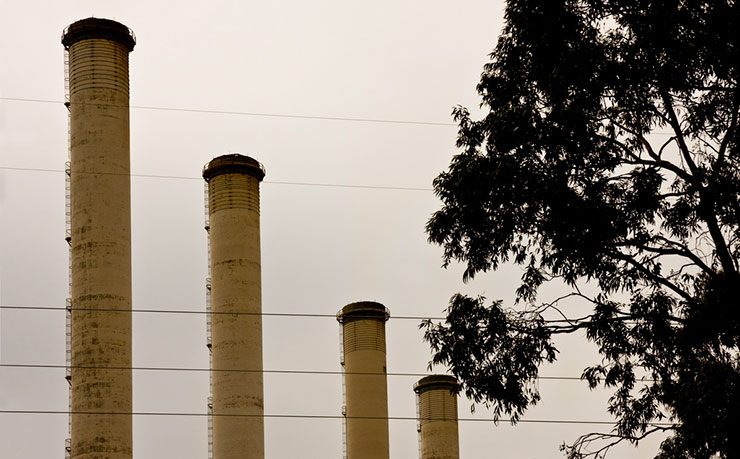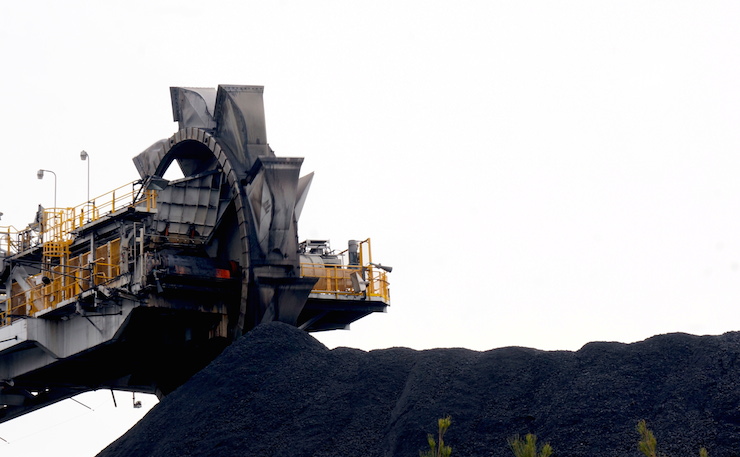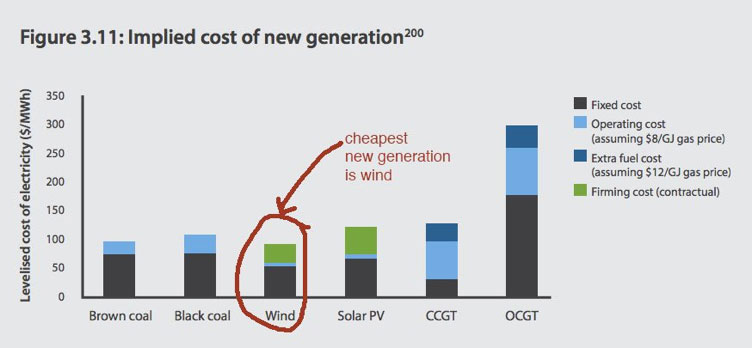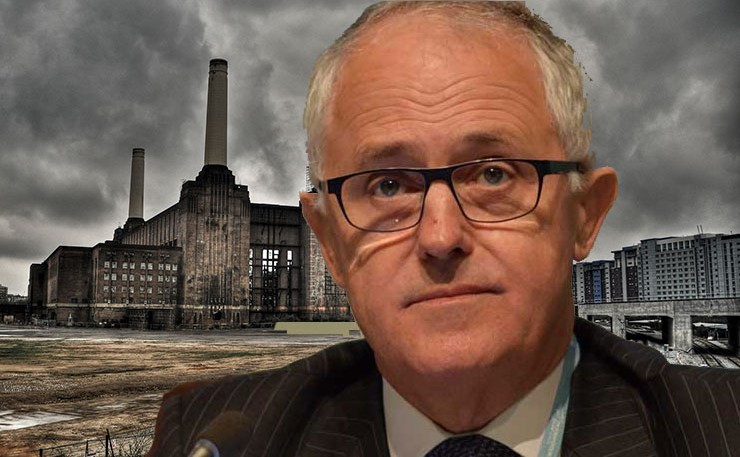When it comes to energy policy, the government has no-one to blame but itself, writes Ben Eltham.
Prime Minister Malcolm Turnbull has run hard on energy this week.
He gave a media conference mid week after the release of the latest report by the Australian Energy Market Operator, or AEMO. AEMO was asked by the government to give advice on electricity supply in the forthcoming summer.
Unsurprisingly, the government is worried about the possibility of blackouts. AEMO says that the national grid “is not delivering enough investment in flexible dispatchable resources to maintain the defined target level of supply reliability.” In other words, there hasn’t been enough investment in new generation, particularly the dispatchable kind.
None of this should be news to anyone, let alone the federal government.
Australia’s electricity grid is undergoing rapid change. The generation mix is changing, and so are the technologies that underpin it. As newer forms of generation like wind and solar are added to the grid, older forms like coal are being phased out. In recent years, we’ve seen the retirement of a significant number of coal-fired power generators, most notably Victoria’s Hazelwood plant in Morwell.

In the long term, this is good news, as renewable energy is the cheapest form of new electricity generation, and will eventually bring prices down. Renewable energy is also cleaner, obviously, which is a good thing if you think dangerous global warming is a problem. But in the short term, there might be some short falls in electricity supply. Which might mean blackouts.
The AEMO report has been misunderstood by many in the media. AEMO is not saying there will be rolling blackouts in the southern states this summer, but it is saying that supply will be tight, particularly on hot days when the wind isn’t blowing. According to AEMO, this is because “radically changing dynamics of the power system are resulting in a tight supply-demand balance in parts of the National Electricity Market.”
AEMO recommends the creation of a 1 gigawatt “strategic reserve” of dispatchable energy (in other words, energy available to be sent to the grid), to ride through any problems on those really hot days. The agency has been preparing for months. According to AEMO’s boss Audrey Zibelman, speaking to the ABC’s Rafael Esptein on Wednesday, “no, we’re not in trouble this summer.”
The government is still worried, though. It knows that when the lights go out, voters tend to blame whoever is in charge. And so they should: this is a failure of planning. The failure is entirely the Coalition’s.
When the Coalition took government in September 2013, it inherited an electricity grid that was in transition. It also inherited a comprehensive plan to manage that transition, in the form of Labor’s Clean Energy Future policy. Labor’s policy represented a plan to transition Australia slowly to renewable energy, but with rather conservative safeguards for energy security. A carbon price penalised dirty industries for pollution, while a renewable energy target subsidised investment in new, clean technology. There was money for technology innovation, and consumers were compensated for the cost of higher electricity bills. Carbon permit sales that raised billions a year provided a steady stream of revenue.
Tony Abbott got rid of all that. He killed the carbon price, slashed nearly all funding to green energy, and launched a jihad against renewables that spooked investors. New renewable energy investment essentially stopped for two years. The government then tried to wind back the Renewable Energy Target by 15,000 gigawatt hours. In the end, after Labor negotiated, the government reduced it by 8,000 GWh, from 41,000 to 33,000 GWh in 2020.
Four years later, we can see the results. Coal hasn’t flourished – indeed, it’s being rapidly phased out. Renewable energy is still the only new generation being built – because it’s the cheapest and most profitable. Electricity bills are even higher than they were under Julia Gillard’s carbon price. Carbon emissions are going up. It’s failure on every front.
Not to put too fine a point on it: this is all the Coalition’s doing. By killing off the carbon price, sabotaging the RET, but refusing to put in place a viable alternative, the Coalition essentially guaranteed that the grid’s problems would deteriorate.

(IMAGE: Thom Mitchell.)
It’s pretty obvious what Australia has needed in energy policy: certainty. The carbon wars have led to crippling uncertainty for investors, terrible outcomes for consumers, and even worse outcomes for the environment. What we should have done was put in place a plan, and stick to it.
As happens so often to this government, political expediency has blinded it to policy reality, such that the inevitable somehow surprises it. But no-one should be surprised that coal plants are closing. They were always going to close.
The sad irony is that no amount of Coalition special treatment can save coal as an electricity source. The dirty black rock has had its day. As the Guardian’s Adam Morton pointed out earlier this year, “coal generators usually operate for about half a century and most Australian plants are pushing that age”. Many of Australia’s plants were built in the 1970s, and have simply reached the end of their productive lives.
Hazelwood, for instance, was built in the 1960s. It was closed by French multinational Engie this year, essentially because it was old, expensive to maintain, and highly polluting. “The closure of Hazelwood is in line with Engie’s strategy to gradually end its coal activities,” the company announced last year. “Besides, Hazelwood power station has been operating in difficult market conditions, with lower electricity prices and a surplus of electricity supply in Victoria State.”
The same can be said for the Liddell power plant in the Hunter Valley, which the government now wants to try and keep operating after 2022. That’s five years away, but the fact that energy oligopolist AGL wants to shut it down makes for a handy political weapon for a government keen to be seen to be doing something – anything – about energy security.
Like everything else to do with this government, ideology has trumped economics, or even common sense. Liddell is 46 years old. It suffered serious boiler leaks in 2016 and 2017. The reason that AGL wants to close Liddell is that it will cost too much to keep running. Upgrading it will be even more expensive, and coal plants don’t make as much money as they used to.
AGL’s boss Andy Vesey always seems to be smiling when you see him the media. Perhaps that’s because the energy giant dominates Australia’s dysfunctional energy markets. High wholesale prices are contributing to fat times for the vertically integrated ‘gentailers’. AGL raked in more than $1.5 billion from its wholesale electricity operations last financial year, contributing to underlying profits of $1.3 billion. While AGL enjoys good publicity for its claims to be getting out of coal, it’s making big dollars from the coal plants it still runs.
Note that the price rises faced by consumers are largely the government’s fault, too. Had it wanted to, the Coalition could have attempted to reform Australia’s absurdly dysfunctional National Electricity Market, in which the price gouging by the energy generators is so profitable. This has nothing to do with renewable energy: it’s simply a consequence of a poorly-designed market where clever oligopolists are gaming the system. But the Coalition hasn’t done anything to reform the NEM either.
All of this is due to policy failure. Australia can have cheaper energy, and still have energy security, and reduce emissions at the same time. We just need a plan.
It’s fairly obvious what should replace antiquated coal plants at the end of their productive lives: new technology that will be cheaper to run and cleaner for the environment. It’s not as though we don’t have the know-how. According to the Finkel Report, which the government commissioned, the cheapest new form of electricity generation is wind. But the govenrment finds such facts inconvenient, because it is completely in thrall to the fossil fuel enthusiasm of the troglodyte Liberal right wing. We’re still waiting for the government’s response to Finkel’s recommendations.

If we need more dispatchable energy, and a more secure electricity grid, the cheapest way to deliver that is by smart grid technologies that better manage demand. Batteries and stored hydro can also play a role. Solar thermal is now being built for the first time in Australia, promising renewable energy at all times of the day or night. A sensible combination of these options will be vastly cheaper than building new coal plants or keeping ageing plants operational well past their use-by date.
The problem for the government is that it is now so invested in the political value of fossil fuels that it seems unable to acknowledge that renewable energy has won the economic race.
“Many of the problems we face at the moment have taken a long time to create,” Turnbull said at his media conference this week. “They can’t be solved overnight.”
He got that right. Energy policy in Australia has been a train wreck for years – roughly, you might say, since the Coalition took office.
Donate To New Matilda
New Matilda is a small, independent media outlet. We survive through reader contributions, and never losing a lawsuit. If you got something from this article, giving something back helps us to continue speaking truth to power. Every little bit counts.







